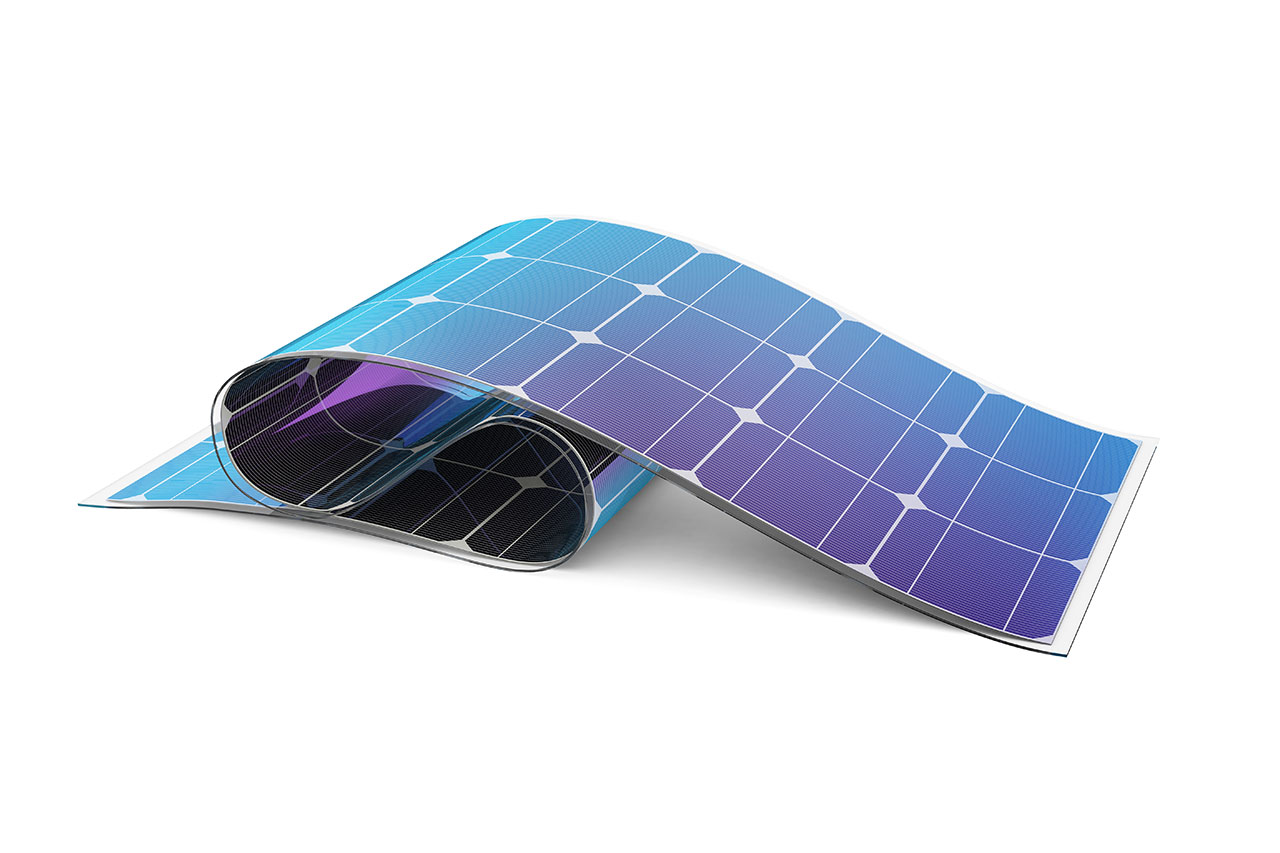Lightweight and flexible cells, a new horizon for solar energy!

Lightweight and flexible photovoltaic solutions are continuously being developed. Numerous projects are emerging, mainly due to increasing yields and falling prices. These technologies are opening the door to new applications which were otherwise inaccessible with heavy and rigid panels. ALCIMED, a consulting firm specialized in innovation and new businesses, reviewed this technological (r)evolution that is opening doors to a world of new photovoltaic applications!
Flexible and lightweight solar panels manufactured using a technology known as “thin films” technology, represents a market of 5.3 GW installed in 2016, well behind the crystalline silicon technology that has passed the 70 GW mark in panels installed in 2016. Although among the thin film technologies, cadmium tellurium (CdTe) is the most advanced (representing 2.3 GW out of the total 5.3 GW installed), it is very brittle and therefore cannot be used to manufacture flexible and lightweight panels.
While crystalline silicon cells reach weights of more than 12kg/m², thin-film technologies, other than CdTe, are currently used to produce cells weighing less than 5kg/m², or even lighter, depending on the support structure used (steel, polyimide,…). These lightweight technologies can be differentiated by their yields:
- Low-yield technologies: amorphous silicon (a-Si), available since the 1980s, has efficiencies ranging from 7 to 9% (about 80 Wp/m²). In the early 2010, organic technologies appeared, showing yields closer to 10%. The first major projects using these organic technologies are starting to emerge, such as a development in La Rochelle, where 500 m² of organic photovoltaic cells (Heliatek) were installed on the roof of the Mendes-France school in order to produce 23.8 MWh of energy; or the Babolat tennis bags with a connected racket (Dracula Technologies).
- CIGS technology (Copper, Indium, Gallium, Selenium) with intermediate yields. After a difficult period in 2013-2016 with the closure of many players involved in the field, advances have been made in terms of yields obtained using this technology. The commercially available CIGS now reaches yields of more than 17% for flexible modules of several hundred square centimeters. Yields and module sizes are expected to continue to grow in the coming years.
- GaAs (Gallium Arsenide) technology offering very high yields: still little used by the general public, its yields reach values of above 25% making it a candidate of choice for specific applications such as in space
Technology prices change rapidly and fluctuate highly, depending on the volumes sold, the choice of the supplier and/or their country of origin. The general trend is an increase in price with an increasing yield. Among the technologies mentioned, CIGS are being positioned as a serious candidate for applications where flexibility, a light weight and high yields are expected at a reasonable price. There are also two other competing technologies that are or will soon be positioned outside the existing categories due to their lack of flexibility or other specific characteristics:
- Perovskites show very promising initial yields and potentially very low production prices due to a simple manufacturing process and low raw materials costs. However, the technology shows stability problems which remain to be solved. It is still being studied in laboratories and commercialization will only be possible in about ten years at a price that is still unknown. It is nevertheless a technology in the making that could potentially shake up the market.
- Lightweight crystalline silicon technology. This is actually an improvement of the classical crystalline silicon technology mentioned above. It is already on the market and has yields similar to CIGS, while offering a much more limited flexibility. However, as its production costs can be even 25% lower, it may be seen as a direct competitor for CIGS in some applications.
Solar energy around your wrist….
Lightweight technologies improve the autonomy of many devices such as connected watches or smartphones. The start-up LunaR is currently developing a connected watch with solar cells on the back of the dial. What’s more, in 2016, Kyocera and Sunpartner introduced a smartphone with solar charging capabilities using a semitransparent solar technology on the screen.
… or mobile solar stations providing autonomy in all circumstances.
Flexible and lightweight solutions stimulate the development of mobile solar stations. They serve as a backup source of energy during emergencies, events (e.g. festivals), military operations, etc. and are meant to replace current generators! There are several other initiatives in this field, such as RenovaGen and its solar carpet or ZephyrSolar and its solar helium balloon.
Towards positive energy buildings….
Another potential application arises in existing buildings with fragile structures (such as industrial or agricultural constructions) which cannot hold conventional solar panels. Apart from that, lightweight cells are also used in the renovation or construction of buildings and particularly their facades. For example, manufacturers such as CrossLux or SunPartner offer semi-transparent energy-producing windows of which the energy can be reinjected into the internal energy circuit. Another step towards positive energy buildings!
… and clean mobility?
The integration of solar panels into the roofs of caravans, motorhomes, recreational boats, buses or trucks, having a sufficient roof area in order to supply the devices inside (refrigerated trailer, small household equipment) is becoming possible, allowing them to stay in unconnected areas for longer periods of time!
“There are endless prospects for lightweight and flexible solar cells. New applications are now addressable by the solar market which should ensure a promising future for this industry.” concludes Jean-Philippe Tridant Bel; Energy, Environment & Mobility Partner at Alcimed.